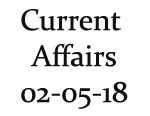-
Current Affairs 2nd May 2018
Updated : 02-May-2018
Current Affairs 2nd May 2018 - Important Points
- Kavinder Gupta sworn in as Deputy Chief Minister of Jammu and Kashmir on - 29th April 2018
- NASA to launch its first mission to study deep interior of Mars on - 5th May 2018
- GOBAR-DHAN Scheme launched to promote wealth and energy from waste by - The Ministry of Drinking Water and Sanitation
- World Asthma Day celebrated globally on - 1st May 2018
- 14 Indian cities figure in World’s 20 most polluted cities list by - WHO
- Union Government releases draft of new Telecom policy on - 1st May 2018
- In-flight mobile connectivity in Indian airspace approved by - Telecom Commission
Current Affairs 2nd May 2018 - Details
Kavinder Gupta sworn in as Deputy Chief Minister of Jammu and Kashmir on - 29th April 2018
Kavinder Gupta, who resigned as the Speaker of J&K Assembly on April 29th, 2018, took oath as the Deputy Chief Minister of J&K, taking place of Bhartiya Janta Party colleague Nirmal Singh.
The sworn-in of office and secrecy was directed to Kavinder Gupta by Governor N.N.Vohra.
Bigger reshuffle in J&K’s PDP-BJP government- This alteration in post was a part of a bigger reshuffle in Jammu and Kashmir’s PDP-BJP government led by Mehbooba Mufti.
- The reshuffle also noticed the introduction of 4 fresh faces- Satpal Sharma from Kathua and Sambha MLAs Rajiv Jasrotia and Devinder Kumar Manyal and Shakti Raj Parihar as State Unit Chief.
- Moreover, Bhartiya Janta Party raised Minister of State for Transport Sunil Sharma to the position of a Cabinet minister.
- The Bhartiya Janta Party also take out 3 ministers - Nirmal Singh, Bali Bhagat and Priya Sethi.
- On the flip side, the PDP released its Law and Rural Development Minister Abdul Haq Khan from the cabinet.
- While, Pulwama MLA Mohd Khalil Band and Sonwar MLA Mohd Ashraf Mir took oath in as cabinet ministers.
NASA to launch its first mission to study deep interior of Mars on - 5th May 2018
NASA will launch its first-ever mission InSight- Interior Exploration using Seismic Investigations,
Geodesy and Heat Transport, to observe the deep-interior of Mars on May 5th, 2018. It will be released
from Space Launch Complex-3 at Vandenberg Air Force Base in California Atlas V rocket. The space-
rocket will also release 2 small-spacecraft called Mars Cube One which is NASA’s technology
experiment.
InSight Mission- InSight is motionless lander that will be 1st NASA’s mission since Apollo moon piers to place
seismometer, which is an instrument that calculates quakes on soil of another planet. - It has been imagined as part of NASA’s Discovery Program mission that focuses to place stationary lander fitted with seismometer and heat-transfer probe on Mars surface to observe red planet’s early geographical evolution.
- InSight is earthly planet explorer that will address one of most fundamental matters of planetary and solar system science. It will benefit in understanding procedures that designed rocky planets of inner solar system over 4 billion years ago.
- The robotic lander will achieve a radio science experiment to observe inner structure of Mars by
positioning seismometer and a burrowing heat probe. - It will calculate Mar’s energetic signals such as pulse seismology, heat flow probe and precision tracking. It will allow researchers understand how its crust, mantle and core are different from Earth.
GOBAR-DHAN Scheme launched to promote wealth and energy from waste by - The Ministry of Drinking Water and Sanitation
The Ministry of Drinking Water and Sanitation has released Galvanizing Organic Bio-Agro Resources –
GOBAR DHAN plan at National Dairy Research Institute Karnal. It was released under Swachh Bharat
Mission by Union Minister for Drinking Water and Sanitation Uma Bharti.
Key Points- The Galvanizing Organic Bio-Agro Resources-DHAN Plan focuses to positively impact village cleanliness and produce wealth and energy from cattle and organic waste.
- It also focuses at forming new rural livelihood options and attractive income for farmers and various rural people.
- Under it, villagers will be prepared to create self-help groups and imaginative societies that will assist in clean energy and green jobs initiative.
- The plan focuses on managing and converting cattle dung and solid waste in farms to valuable compost, biogas and bio-CNG, therefore, keeping villages clean, raising income of rural households and production of energy from cattle dung. The plan imagines application of 700 bio-gas units in various states of the nation in 2018-19.
- It will be enormously helpful for nation as India is home to highest cattle population in world which
generates about three million tonnes of dung. - It will provide various benefits to countryside people by maintaining villages clean and sanitized,
cultivating livestock health and growing farm yields. - Under it, biogas production will help to upsurge self-reliance in energy usage for cooking and lighting.
- It will enlarge income of farmers and cattle herders. It will form new options for jobs related to waste collection, transportation, biogas sales and many more.
- It will also deliver stable fuel supply in market for oil organizations and available credit in market through government plans and banks for businesspersons.
World Asthma Day celebrated globally on - 1st May 2018
GINA ( Global Initiative for Asthma) celebrated World Asthma Day on 1st May 2018 with the theme 'Never too early , never too late. It's always the right time to address airways diseases.
Ashtma is a big pravelent problem in both developing and developed countries ass per WHO.
Important Highlights
- It's a chronic lung disorder caused due to air inflammation.
- Airways become narrower and filled with mucus, henceforth block the airflow.
- If attack comes from Asthma isn't controlled on time, person may die.
- Certain medications can control this non-communicable disease.
14 Indian cities figure in World’s 20 most polluted cities list by - WHO
According to the information released by the WHO, fourteen Indian cities figure in a list of worlds’ 20 most polluted cities for particulate matter 2.5 levels in 2016. The particulate matter PM2.5 consists of pollutants like sulphate, nitrate and carbon, and these all pose the higher risk to human health.
The World Health Organisation Global Urban Ambient Air Pollution Database ranked Kanpur as the maximum polluted city among 4300 world cities which were observed for their air pollution levels in the year 2016.
The additional Indian cities that listed very peak levels of PM2.5 pollutants were Faridabad, Varanasi, Patna, Delhi, Lucknow, Agra, Srinagar, Gurgaon, Jaipur, Jodhpur and Patiala.
WHO Global Urban Ambient Air Pollution Database- The information highlighted that nine out of ten people in the world breathe highly polluted air.
- About seven million people passes away every year from exposure to polluted air that chokes the lungs and cardiovascular system, resulting stroke, heart disease, lung cancer, COPD and respiratory infections.
- Air pollution is also a serious risk factor for noncommunicable diseases, causing 24% of all adult deaths from heart disease, 25% from stroke, 43% from COPD and 29% from lung cancer.
- Ambient air pollution caused around 4.2 million deaths in 2016, whereas household air pollution from cooking with polluting fuels triggered more than 3.8 million deaths in 2016.
- The maximum ambient air pollution levels are in the Eastern Mediterranean Region and in South-East Asia, followed by Africa and the Western Pacific.
- World Health Organisation has called upon associated nations in its Southeast Asia Areas to address the double load of household and ambient air pollution as the region, which comprises India, results into 34% premature deaths globally yearly.
Union Government releases draft of new Telecom policy on - 1st May 2018
The Union Government published the draft of a new Telecom policy- National Digital Communications Policy, 2018, on May 1st, 2018. The policy focuses to deliver broadband coverage with 50Mbps speed to every resident, attract USD 100 billion investment in the telecom sector and generate 40 lakh new jobs by 2022.
Important Highlights- Policy Goals The fresh telecom policy draft focuses to make sure universal broadband coverage at 50Mbps to every resident.
- It proposes to provide One Gbps speed to all Gram Panchayats by 2020 and 10 Gbps speed by 2022.
- It also suggests to address the woes of the Telecom sector by rereading licence fees, spectrum usage charges, and universal service obligation fund charge for enhancing ease of performing trade in the sector.
- It also suggests aim to fascinate investments worth USD 100 billion in the digital com sector by 2022.
- Further, the policy understands the reputation of continued improvement in the regulatory framework for attracting investments and making sure fair-minded competition, to serve the requirements of the people.
- It focuses to attract long-duration, high-quality and sustainable funds, given the sector's capital-intensive nature.
In-flight mobile connectivity in Indian airspace approved by - Telecom Commission
The high-powered inter-ministerial Telecom Commission, led by Telecom Secretary Aruna Sundararajan, passed in-flight mobile connectivity in Indian aeroplanes on May 1st, 2018, therefore, permitting people to make phone calls and practice internet services in flights over Indian airspace. Telecom Commission’s sanction comes months after the telecom regulator TRAI suggested for in-flight mobile telephony and internet services.
In-Flight Connectivity- The Internet and Mobile Communication on Aircraft service will be allowed as In-Flight Connectivity in the Indian airspace.
- The Mobile Communication on Aircraft facilities will be allowable with atleast height limit of 3000m in Indian airspace for its compatibility with earthly mobile networks.
- Now, the government will work for generating the license for a special class of service providers known as ‘In-flight connectivity provider’.
Significance - The implementation of this action will improve the passenger experience, with passengers being capable to order products from their smartphones and laptops and having them transported to their homes on arrival at their destination.
- Through in-flight mobile connectivity, cabin crews will be able to assist travelers to alter their onward transit plans to lodge changes to their flight, while they are still in flight.














